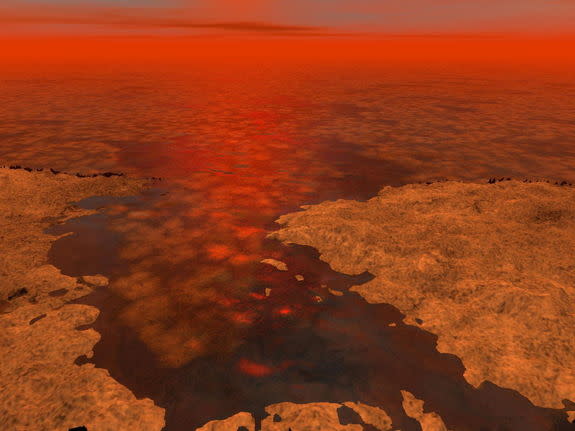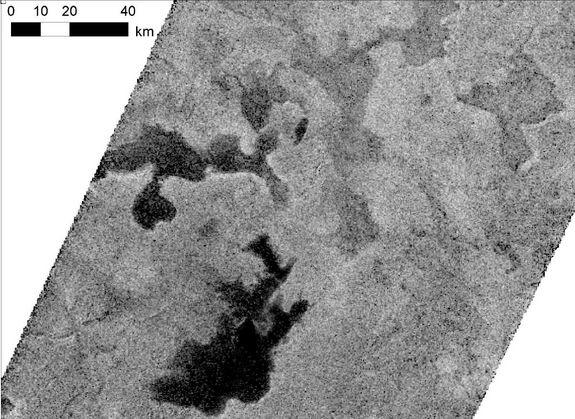Saturn Moon Titan May Have Ice Floating in Lakes
Chunks of hydrocarbon ice may float atop the lakes and seas of Saturn's huge moon Titan, a new study reveals.
The presence of such ice floes in the ethane and methane seas on Titan would make the moon an even more exciting target for astrobiologists, researchers said.
"One of the most intriguing questions about these lakes and seas is whether they might host an exotic form of life," study co-author Jonathan Lunine of Cornell University said in a statement. "And the formation of floating hydrocarbon ice will provide an opportunity for interesting chemistry along the boundary between liquid and solid, a boundary that may have been important in the origin of terrestrial life."
Titan — Saturn's largest moon, with a diameter of 3,200 miles (5,150 kilometers) — is the only body in our solar system apart from Earth known to host stable bodies of liquid on its surface. While Earth's weather cycle is based on water, Titan's involves hydrocarbons, with liquid ethane and methane falling as rain and pooling in large lakes and seas. [Amazing Photos of Titan]
NASA's Cassini spacecraft has spotted a huge network of these seas in Titan's northern hemisphere, along with a handful in the moon's southern reaches.
Cassini scientists had previously assumed that these seas would not have floating ice, since solid methane is denser than its liquid counterpart and should thus sink. But the new study suggests that things are not so simple.
The researchers created a model investigating how Titan's seas interact with the moon's nitrogen-rich atmosphere, creating pockets of varying composition and temperature.
The team determined that hydrocarbon ice should indeed float in the moon's seas, as long as the temperature is just below methane's freezing point — minus 297 degrees Fahrenheit, or minus 183 degrees Celsius — and the ice is at least 5 percent "air," which is the average composition for young sea ice here on Earth.
This ice may be colorless, perhaps with a reddish-brown tint provided by Titan's atmosphere, researchers said.
"We now know it's possible to get methane-and-ethane-rich ice freezing over on Titan in thin blocks that congeal together as it gets colder — similar to what we see with Arctic sea ice at the onset of winter," lead author Jason Hofgartner, also of Cornell, said in a statement. "We'll want to take these conditions into consideration if we ever decide to explore the Titan surface some day."
Floating sea ice could be a fleeting phenomenon on Titan, if it exists at all. If the temperature drops a few degrees, the ice will begin to sink, researchers said.
Cassini should be able to test the new model out, and soon. Titan's northern spring is underway, meaning lakes and seas in the moon's northern reaches are warming up.
As this happens, ice may rise to the top, creating a surface that appears brighter and more reflective to Cassini's radar instrument. As the area continues to warm, the ice should melt, producing an entirely liquid surface that will look darker to Cassini, researchers said.
"Cassini's extended stay in the Saturn system gives us an unprecedented opportunity to watch the effects of seasonal change at Titan," Linda Spilker, Cassini project scientist at NASA's Jet Propulsion Laboratory in Pasadena, Calif., said in a statement. "We'll have an opportunity to see if the theories are right."
The $3.2 billion Cassini mission, a joint effort of NASA, the European Space Agency and the Italian Space Agency, launched in 1997 and arrived at Saturn in 2004. It will continue to observe the ringed planet and its many moons through at least 2017.
Follow SPACE.com on Twitter @Spacedotcom. We're also on Facebook & Google+.
Copyright 2013 SPACE.com, a TechMediaNetwork company. All rights reserved. This material may not be published, broadcast, rewritten or redistributed.


